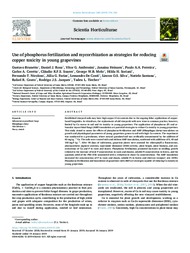Use of phosphorus fertilization and mycorrhization as strategies for reducingcopper toxicity in young grapevines.
Use of phosphorus fertilization and mycorrhization as strategies for reducingcopper toxicity in young grapevines.
Autoria: BRUNETTO, G.; ROSA, D. B.; AMBROSINI, V. G.; HEINZEN, J.; FERREIRA, P. A. A.; CERETTA, C. A.; SOARES, C. R. F. S.; MELO, G. W. B. de; SORIANI, H. H.; NICOLOSO, F. T.; FARIAS, J. G.; DE CONTI, L.; SILVA, L. O. S.; SANTANA, N.; COUTO, R. R.; JACQUES, R. J. S.; TIECHER, T. L.
Resumo: Established vineyard soils may have high copper (Cu) contents due to the ongoing foliar applications of copper-based fungicides. In viticulture, the replacement of old vineyards with new vines is common practice, however,limited by Cu excess in soil and its toxicity to young grapevines. The application of phosphorus (P) and ar-buscular mycorrhizal fungi (AMF) inoculation are potential strategies to reduce Cu toxicity to young grapevines.This study aimed to assess the effects of phosphorus fertilization and AMF (Rhizophagus clarus) inoculation ongrowth and physiological parameters of young grapevines grown in soil with high Cu content. The experimentwas conducted in a greenhouse, where natural grassland soil was artificially contaminated by the addition of60 mg kg−1Cu. The soils were treated with and without AMF inoculation, combined with additions of 0, 40 and100 mg P kg−1. After 90 days of cultivation, grapevine plants were assessed for chlorophyllafluorescence,photosynthetic pigment contents, superoxide dismutase (SOD) activity, plant height, plant biomass, and con-centrations of Cu and P in roots and shoots. Phosphorus fertilization promoted increases in seedling growth(related to the increase of total P concentration in roots and shoots), soluble Pi concentration in leaves, and thequantum yield of the PSII (YII) (associated with a reduction in shoot Cu concentration). The AMF inoculationincreased the concentration of P in roots and shoots, soluble Pi in leaves and electron transport rate (ETR).Phosphorus fertilization and inoculation of grapevines with AMF are strategies capable of reducing Cu toxicity inyoung grapevines.
Ano de publicação: 2019
Tipo de publicação: Artigo de periódico
Unidade: Embrapa Uva e Vinho
Palavras-chave: Arbuscular mycorrhizal fungi, Rhizophagus clarus, Vitis labrusca L
Observações
1 - Por padrão são exibidas publicações dos últimos 20 anos. Para encontrar publicações mais antigas, configure o filtro ano de publicação, colocando o ano a partir do qual você deseja encontrar publicações. O filtro está na coluna da esquerda na busca acima.
2 - Para ler algumas publicações da Embrapa (apenas as que estão em formato ePub), é necessário ter, no celular ou computador, um desses softwares gratuitos. Sistemas Android: Google Play Livros; IOS: iBooks; Windows e Linux: software Calibre.
Acesse outras publicações
Acesse a Base de Dados da Pesquisa Agropecuária (BDPA) para consultar o acervo completo das bibliotecas da Embrapa.

